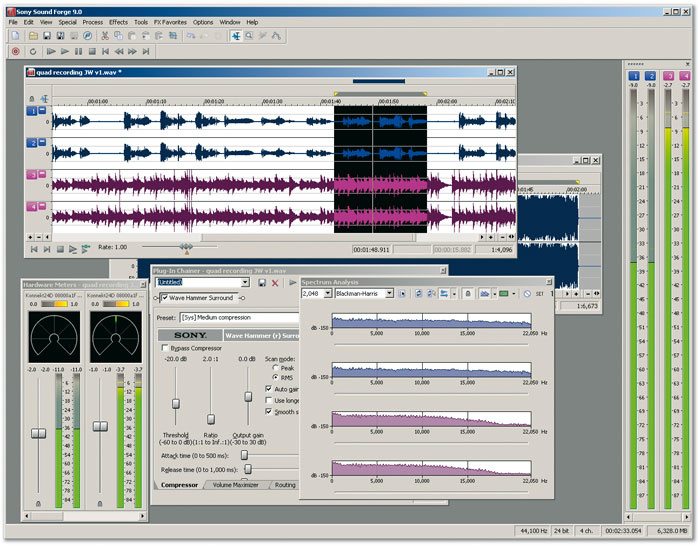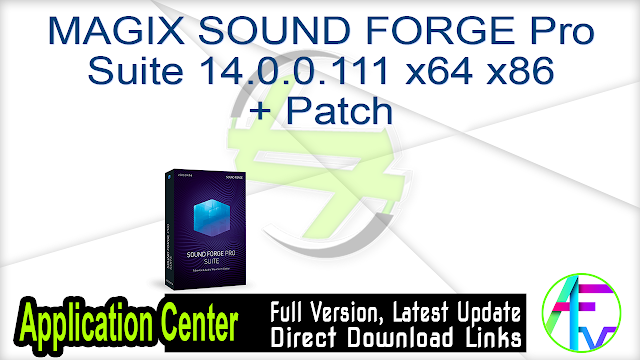How To Get Sound Forge To Recognize My Vst Plugins
- How To Get Sound Forge To Recognize My Vst Plugins Free
- How To Get Sound Forge To Recognize My Vst Plugins Download
- How To Get Sound Forge To Recognize My Vst Plugins Youtube
- How To Get Sound Forge To Recognize My Vst Plugins Torrent

VST stands for Virtual Studio Technology. There are three types of VST plug-ins:
Discover SOUND FORGE Audio Studio 14, the audio tool that offers professional results in no time at all and with just a few clicks. Recording Professional recording made easy: Record vocals, sounds and podcasts in excellent quality at up to 32-bit/384 kHz with this fast, uncomplicated and reliable audio editor. Hey everyone, I just finally updated to 1.6 and all has been groovy until I tried loading up Reaktor 5 VST plug in. I started a new project, threw in a simple bass beat and I can hear it in my speakers and everythings good, but as soon as I open up any plugin etc, the bar is still moving across while playing but no sound! Uninstall your current version, install the new version you downloaded. If this does not work, you can go into your c: program files waves directory, and drag and drop the plugins’ DLL files into Sound Forge. To do this, first open Sound Forge, make it not full screen so you can view the plugin folder along side SF. The minimum term begins on the date of purchase. If you cancel your order within 14 days, you will receive a complete refund. The contractual period of SOUND FORGE Pro Suite 365 will be automatically extended by one month at a time until you cancel the agreement You will be informed well in advance if the extension rate or taxes included change.
How To Get Sound Forge To Recognize My Vst Plugins Free
- Every time I add a new VST Sound Forge wants to rescan all plugs on startup. No biggie except about every other time it gets hung up on any one of several Native Instruments plugs and just keeps rescanning the same three or four plugs until I kill it. I've gone in and told SF to not use.
- 'I consider SOUND FORGE and Samplitude to be the ultimate couple for my music. I do the hard work in Samplitude, and finalise with SOUND FORGE Pro, which itself has greatly improved from its previous versions, allowing to work with multichannel audio, ARA2, and improved VST plug-in integration.'
How To Get Sound Forge To Recognize My Vst Plugins Download
- VST instruments: These plug-ins generate audio and are either virtual synthesizers or samplers. Many VST instruments emulate the appearance and sound of famous hardware synthesizers. Popular VSP instruments include Massive, FM8, Absynth, Sylenth 1, Reaktor, Gladiator, Vanguard, and Omnisphere.
- VST effects: Effects process audio instead of generating it. VST effects function like hardware audio processors, like reverbs and phasers.
- VST MIDI effects:MIDI plug-ins process MIDI messages and send MIDI data to other VST instruments and hardware.

How To Get Sound Forge To Recognize My Vst Plugins Youtube
VST Plug-ins
VST plug-ins can be used within a digital audio workstation, in programs like Pro Tools and Logic. They’re frequently used to emulate hardware outboard gear such as compressors, expanders, equalizers, and maximizers. You'll frequently find these distributed to emulate certain models of hardware; there's some for vintage compressors, and you'll frequently find effects that emulate vintage hardware (both in instrumental and stompbox-like effects).
Think of VST plug-ins as really affordable ways to make your home studio sound like a really expensive commercial operation.
VSTi Plug-ins
/nomad-vst-plugins-free.html. Aside from VST plug-ins, you'll also find VST-instrument or VSTi plug-ins. These can emulate really cool, but expensive, hardware (like Hammond B3 and Nord Electro). The quality of these VSTi plug-ins can vary from acceptable to really poor; it all depends on the quality of your system resources (RAM and scratch space on your hard drive, for example), and how well-sampled the instrument is. You also want to make sure that your VSTi plug-in offers true polyphonic content, meaning you can make life-like chords that don’t sound too artificial.
Quality
There are thousands of plug-ins available. Some only take a few hours to produce and are free, but the quality is terrible. Some are made by huge companies and sound amazing, but are expensive. VST plug-in developers try to recreate the sound as closely as possible, but the original instrument is probably always going to sound better than the plug-in. You might be trying to get the rich, full-bodied sound of an organ, for example, but who owns an organ? No one has access to every type of instrument, so a plug-in will have to do. The good news is that VST plug-in technology is improving, so quality can only get better with time.
VST Plug-in Standard
How To Get Sound Forge To Recognize My Vst Plugins Torrent
Created by Steinberg, a German musical software and equipment company, the VST plug-in standard is the audio plug-in standard that allows third-party developers to make VST plug-ins. Users can download VST plug-ins on Mac OS X, Windows, and Linux. The vast majority of VST plug-ins are available on Windows. Apple’s Audio Units are standard on Mac OS X (it’s actually considered a competing technology), and Linux lacks commercial popularity, therefore few developers create VST plug-ins for the operating system.
Where to Find VST Plug-ins
There are thousands of VST plug-ins available, both commercially and as freeware. The Internet is flooded with free VST plug-ins. Home Music Production and Bedroom Producers Blog have robust lists of VST plug-in recommendations, and Splice and Plugin Boutique also offer a ton of free plug-ins.